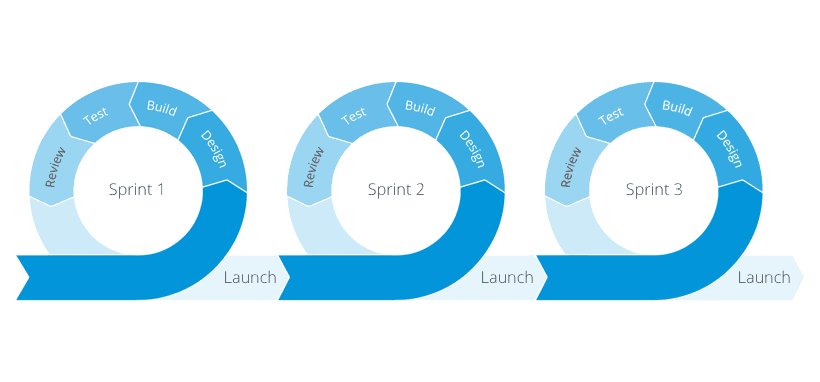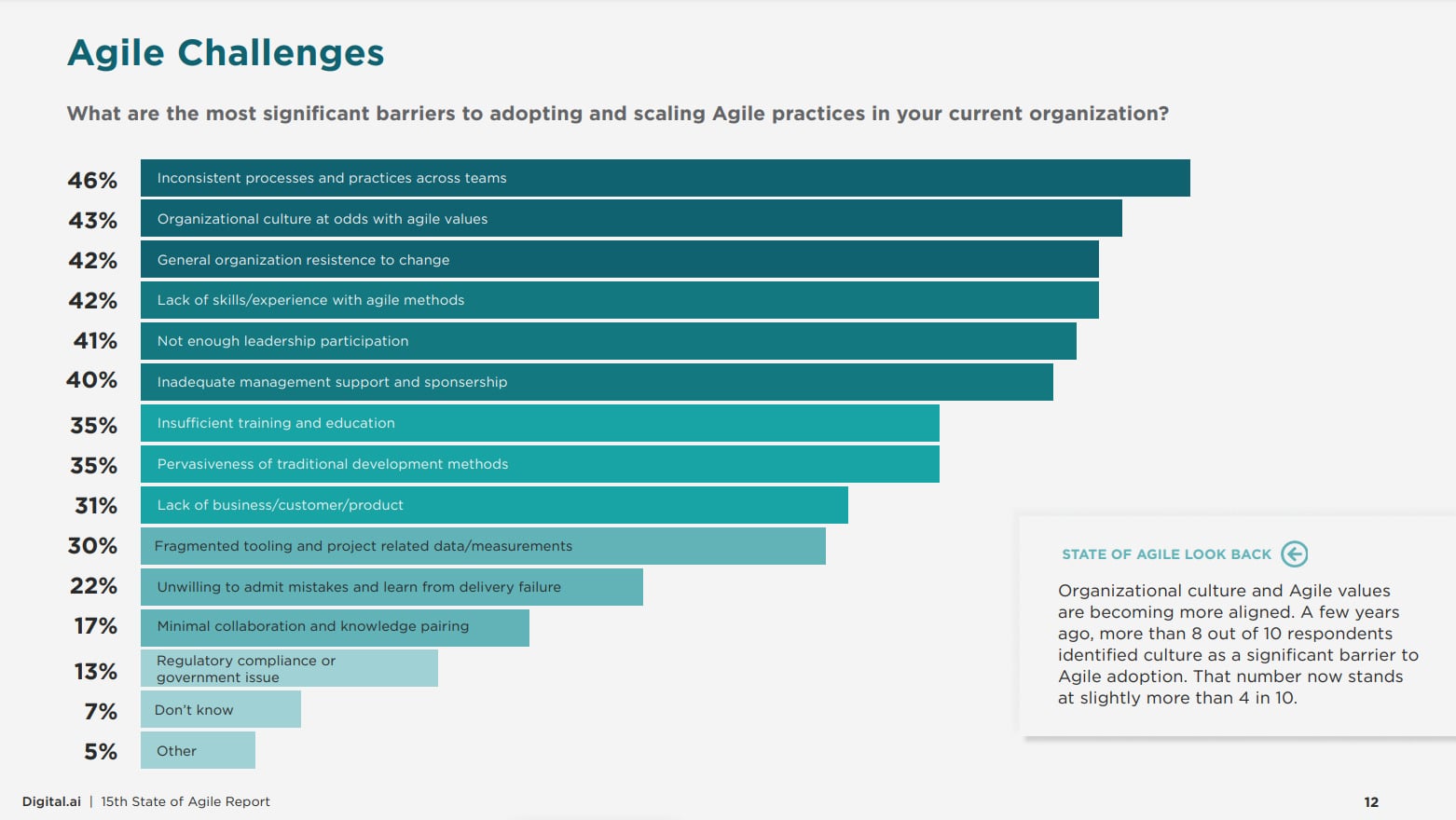Pros and Cons of Agile Approach: CTO’s Perspective
corporate cultureIn 2021, Agile is not only about software development, it’s everywhere. In fact, it got widespread adoption and can be implemented even in childcare now. In view of this, one might say that it turned into a buzzword. But I think that each methodology should be applied in a reasonable and controlled manner.
That’s why I decided to share my thoughts on Agile software development. In this article, I’ll discuss the fundamental points of Agile methodology and go through the pros and cons of its adoption.
The basics of Agile
The Agile way of working is based on the 12 principles that can be found in the Agile Manifesto. Below, you can find the list of Agile fundamentals we summarized for you.
- Having a transparent and highly collaborative development process.
It means constant internal team communication and contact with the customer. That’s why regular meetings are a must!
- Dividing the project into iterations.
Iterations are repeated work phases (timeboxes) with defined tasks and final meetings (retrospectives). In most cases, the duration of an iteration ranges from 1 to 4 weeks and is fixed for a particular project.

- Introducing story cards and product backlog.
The story cards tell the product story and show why a feature is important and how the user will interact with it. The product backlog, in its turn, is a prioritized list of tasks to be done. It allows the development process to be flexible, yet measurable.
- Having a definition of done right from the start.
Changes in customer requirements are welcomed at any time in the Agile process. However, they aren’t inserted into an ongoing iteration, as they will be integrated into the next run.
The thing is, during an iteration, the team should concentrate fully on the agreed scope of work. Thus, it won’t be changed because of the lack of time.
Considerations for agile development
Agile development methods are currently in vogue. However, as with any other project management technique, it has its pros and cons. Let’s discuss them.
Advantages of agile software development
Agile methods offer 7 key advantages.
- Focus on quality
When software development is broken down into small chunks, it’s much easier for project teams to focus on testing and reviewing each iteration. In addition, Agile teams can quickly find and fix software bugs.
- Focus on the customer
At Agile, the focus is on the continuous release of high-quality software. Here, customer feedback and satisfaction have a direct impact on product development.
- Focus on transparency and communication
Agile software development emphasizes collaboration and user involvement. All stakeholders from all project areas actively give feedback on the software.
- Focus on flexibility
Project managers can easily change priorities and redefine what’s important for the product – even if that changes every week. In such a way, goals that have not yet been achieved can easily be carried over into later iterations.
- Focus on speed
Thanks to incremental delivery, software developers always have a part of a finished product available. We couldn’t agree more that speed is the biggest asset of Agile. According to the 9th State of Agile Survey, the most frequently cited advantage of Agile methods is the accelerated product launch.
- Focus on risk minimization
Project managers can use iterations to adapt to a changing software environment. With incremental software releases, bugs and problems can be identified early on, before the launch of the product. That’s why bug fixes become not so difficult.
- Focus on managing lean budgets
Breaking projects down into smaller chunks (often called sprints) makes it easier to forecast costs. In addition, teams can get their compensation as soon as specific releases are finished.
Disadvantages of Agile software development
Agile is a great option for many software development teams, but it doesn’t have to be right for every team. Before adopting Agile project management methods, you should know their possible disadvantages.
- Agile is less than ideal for government agencies and large corporations
Detailed documentation is incompatible with Agile methods as they require comprehensive transparency. For less flexible companies, Agile methodology can therefore be more of a hindrance.
- Pending deliveries may override the quality in the case of long-term projects
If new software iterations are constantly expected, it can affect the quality assurance of the long-run projects.
- Change costs are ignored
Often, errors that were straightforward at the beginning become more and more difficult to fix. It happens because the source code is constantly changing.
- Agile works poorly on teams that want tight supervision
Agile is a great product development process for small teams that work well together. However, the IT department can consist of a large number of employees. Also, mind that the whole system often fails because of the weakest link in the chain.
- Agile takes practice
The latest State of Agile Report shows that a lack of skills and experience is one of the main Agile adoption challenges. The thing is, waterfall methods for project management can be used intuitively. Whereas learning Agile methods takes some time.

Why is Vilmate choosing agile?
#1: Agile software development is much faster.
Agile software development enables us to react very quickly to changing market conditions.
Classic software development originated at a time when the software was still installed locally on a computer. This made it impossible to continuously improve the software. Instead, the customer was repeatedly provided with major updates about installation.
In classic software development, the goal was to provide seemingly “perfect” solutions to the customer. However, this meant that the development cycles were extremely long and the software could not be tested in detail in “live operation”.
Moreover, the market conditions and customer requirements often changed during the development phase, even before the changes were released.
#2: Agile creates intuitive usability for users.
More than ever, we are used to the fact that we can operate technical devices intuitively in our everyday lives. For example, we don’t need anyone to train us to use an iPhone because, during development, much effort has been spent to make processes intuitive.
Agile software development plays a central role in creating intuitive usability. Whereas in classic software development, the design was something that made the surface “beautiful”.
Vilmate has User Experience Designers “journey” through the software to complete a specific task. Based on this, we design the interfaces that draw the user’s gaze directly to the main elements of the frame.
To achieve such a goal, we at Vilmate test our software interfaces very early and extensively with our customers. We observe which actions users intuitively perform. To that end, we often use so-called click dummies.

Click dummies imitate fully functional software. In reality, however, they have only linked image components. This enables us to make continuous adjustments very quickly and in a resource-saving manner. We use them before starting the development of the final product.
#3: Agile software development drives innovation.
At Vilmate, however, we are not pursuing the goal of digitizing existing analog processes. We believe that bad analog processes are also bad digital processes.
We aim to rethink processes and improve them holistically. The most important expert in development is the user. After all, who knows better than users about the problems they encounter daily.
When it comes to finding a solution, it’s our task to question what already exists and to adopt new perspectives. For this purpose, we at Vilmate have an interdisciplinary product team. Its members come from a wide variety of industries and bring a lot of digital know-how with them.
Conclusion
Agile software development is more than just a project management fashion. It’s a separate project management discipline with clear advantages, especially for IT teams. These methods focus on transparency, iterative processes, and clear communication. All this leads to the improved quality of the end product.
However, mind that Agile takes practice. And the lack of sufficient knowledge and experience is one of the top reasons why agile projects can fail.
Vilmate company has been delivering successful software development projects since 2012. On top of that, our team knows how to make Agile methodology implementation benefit the customer - and not cost.
Do you want your project to rock? Contact us, and we’ll find the most suitable delivery approach to help your business thrive.



![How to Choose the Right Outsourcing Company [Checklist]](https://vilmate.com/wp-content/uploads/2021/04/2021-04-22_16.48.43-250x150.jpg)
